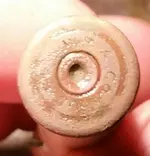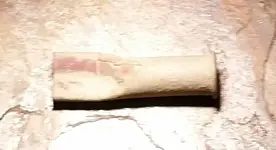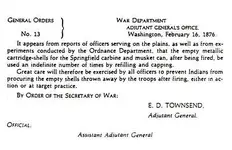Again thank you for your comment. But I never claimed this one shell casing was used in an Indian engagement! And as for the year it's on the head stamp you just can't make it out in the picture. As I stated above it fits the time frame for military use in the area. "And again I don't mean in battle."
Ok, based on what you said here...."Thanks for your comment but Michigan has a long history with Indians"................ I thought you were implying that it came from an actual engagement or contact with Indians --- my misunderstanding.
I will add food for thought about the "crushing" directive though......... back in the 1990's I spent many years living in staff housing at FT. GRANT, AZ. which was in big use during the Apache Wars, and then later given by the fed's to the Arizona at statehood. It was turned into first an Industrial School (reform school), and later became an adult prison in the 70's which is where I worked. To say that casings, especially 45-70, were a common find is an understatement. And an interesting thing is that just as many were in great shape (especially if recently uncovered by a big rain) as were crushed, whether purposely or not. I have a shoebox full of beautiful condition casings with 1880's-90's headstamps. When I first got there I picked up "all" of them, but then when I realized how common they are, I then only picked up pristine ones... then it became only the tin plated ones!
SO I suppose my point is that even in a controlled environment of a major post during a time of "hostility" .... the directive was not as "followed" as it might be believed.
My big hunt these days is for short term "encampment" areas.... a place that was used to protect/guard a route, spring, etc by leaving a small detachment there...and I will say the same thing applies with those as the big post, that there was no indication a purposely smashing casings for the most part.... Ones I dig closer to the surface are often smashed by the elements/people/animal traffic, etc.... and in "some" cases purposely --- they usually have a smashed rim as well (you can tell someone took their buttplate to it).
But if they are not close to the surface, they tend to be in great shape.... and this indicates to me that these soldiers didn't give a crap about "policing" their brass. At these encampments its often obvious that they were allowed to take up 'target practice' to some degree, as I often find period cans/lids that have been targets along with the casings..... and you would think if this directive was being enforced, that it would be ESPECIALLY in these remote locations that they wouldn't want to leave anything salvageable for the "enemy."
At a cartridge collectors show a few years ago, this policy was discussed with a guy that was well versed on it. He stated that its whole reason for being was that 'proof' had popped up on the northern plains that a few Indians had learned to "reload" spent brass, but that in the "wilds" of the west the order was largely ignored, and that is why so much military brass of that era is found uncrushed out here..... maybe back east, a more regulated "peacetime" army did follow this... who knows.
But I will make a post of today's finds in a bit from a very unusual encampment area..... no matter what, I hope you hit that area hard and pop up some more goodies.




